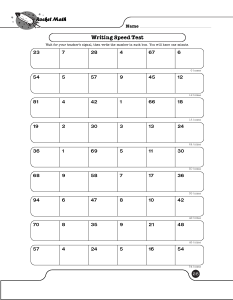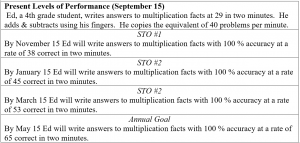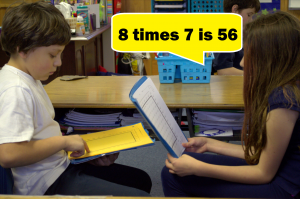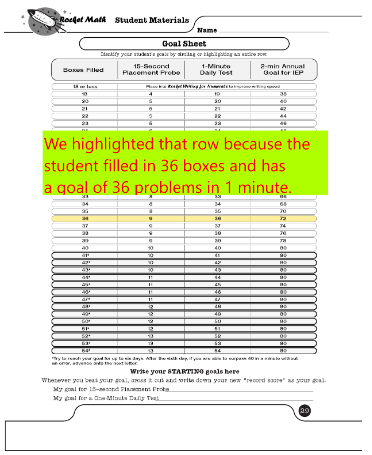Setting IEP goals and short-term objectives is a snap when you measure growth in fluency. Not only are fluency growth goals easy to write and set, but they are also easy to measure and monitor. You can adjust the intensity of the intervention ensuring the student can achieve the goals and objectives. Finally, you’ll be able to demonstrate growth and improve student achievement.
What are Math fact fluency IEP goals?
Math fact fluency goals are specifically designed to help students master basic math facts so that they can move on to more advanced topics. These goals should be tailored to each individual student’s level of understanding. They should focus on mastering basic operations such as addition/subtraction or multiplication/division, as well as developing problem-solving skills. In addition, these goals should also focus on increasing the speed at which the student can answer questions correctly in order to improve their overall math performance.
Why are math fact fluency IEP goals important?
In addition to targeting academic performance, math fact fluency goals can also help improve overall mathematical fluency, which is defined as being able to solve mathematical problems quickly and accurately without relying too heavily on counting strategies or written algorithms. Mathematical fluency is important because it allows students to think critically about numbers and apply strategies learned from one problem type (i.e., fractions) across different contexts (i.e., decimals). Thus, having an IEP goal related to increasing math fact fluency can help foster overall mathematical fluency by providing students with the necessary building blocks for success in more advanced topics.
How to set math fact fluency IEP goals
When setting math fact fluency IEP goals, it is imperative to consider the student’s current abilities when determining the target goal. Each student should have individualized goals based on their specific needs and abilities. A good starting point for setting these goals would be to identify the number of correct responses per minute (RPM) that the student currently achieves and then set incremental increases from there. For example, if a student achieves five correct responses per minute (RPM), this could be the baseline starting point for setting future IEP goals.
In addition to increasing RPM, other possible goals include mastering certain operations or combinations of operations within a given timeframe or reducing errors in computation tasks. The ultimate goal should be for every student to reach mastery over all four operations by the end of their educational program—which would equate to correctly answering all four operations at 10 RPM without any errors.
Test the student’s present level of performance (PLOP) on math fact fluency
 It only takes a minute or two to have students take a timed test in an operation to see how well they know their facts. You want to know how many facts the student can answer in that operation in one minute. Test first-grade students in addition and second-graders on subtraction. Starting in 3rd grade and up, multiplication has priority, so test and focus on multiplication facts for your IEP. You can move on to other operations once multiplication facts are fluent. Here is a link to a page with Rocket Math’s one-minute pre-tests in all four basic operations. However, you can’t evaluate whether a given student is fluent until you know how fast they can write. Students who are fluent with facts can answer them about as fast as they can write. But they cannot answer them any faster than they can write.
It only takes a minute or two to have students take a timed test in an operation to see how well they know their facts. You want to know how many facts the student can answer in that operation in one minute. Test first-grade students in addition and second-graders on subtraction. Starting in 3rd grade and up, multiplication has priority, so test and focus on multiplication facts for your IEP. You can move on to other operations once multiplication facts are fluent. Here is a link to a page with Rocket Math’s one-minute pre-tests in all four basic operations. However, you can’t evaluate whether a given student is fluent until you know how fast they can write. Students who are fluent with facts can answer them about as fast as they can write. But they cannot answer them any faster than they can write.
Test the student’s writing speed
 You cannot set achievable goals of how many facts a student should answer in a minute without first knowing how fast they can write. That sets the upper limit. So test their writing speed by having them write a mix of one and two-digit numbers for one minute. See above, the Rocket Math’s one-minute Writing Speed Test. From the link you can print it out for free. Once you know how fast your student can write you can evaluate their performance on the one-minute fluency tests.
You cannot set achievable goals of how many facts a student should answer in a minute without first knowing how fast they can write. That sets the upper limit. So test their writing speed by having them write a mix of one and two-digit numbers for one minute. See above, the Rocket Math’s one-minute Writing Speed Test. From the link you can print it out for free. Once you know how fast your student can write you can evaluate their performance on the one-minute fluency tests.
Set the progress monitoring measure
If you’re going to test every week with 1-minute timings and you have a bunch of those available, you already have a 1-minute timing starting point. If you’re using the Rocket Math Worksheet Program as your intervention, it uses 2-minute timings to measure progress weekly, so you’ll want to use one of those for your starting point. (You can’t double the 1-minute score because students don’t usually keep up at the same rate for two minutes.) So give one of the 2-minute timings in the operation you will focus on to set a starting point.
Set the math fact fluency goal based on writing speed
Students who have successfully developed math fact fluency in an operation can write answers to math facts almost as fast as they can write. As fast as their fingers can carry them is the most you could expect. You could set a goal at 80% of their writing speed. It would still be rigorous enough. If they met that goal the student would be fluent in math facts.
You can do the math yourself from their writing speed test. The Rocket Math Worksheet Program has weekly progress monitoring 2-minute timings. In that case, your student’s goal for the 2-minute timing is on the handy goal sheet ** that you put into each student’s folder. You can see the student shown here filled in 36 boxes on the Writing Speed Test, so his or her goal for 2-minute timings would be 72 for the annual goal for the IEP.
Create a graph with an aimline
Now the coolest thing about progress-monitoring a fluency goal is that it is easy to graphically see on a weekly basis if the student is on track to meet the goal. You simply create a graph, with enough spots at the bottom for all the weeks in the year. Next you put in the starting point performance in the first week of the graph (or whenever you tested). Then put in your goal performance at the end of the year. Then draw a line between those two points. That line is called the aimline and is shown in the example below.
The student, whose aimline is pictured above, began at 29 problems in 2-minutes. Their present level of performance, or PLOP, was 29 problems correct in 2 minutes. The student had a writing speed of 40 problems in a minute. Therefore 80% of that is 32 problems in a minute or an Annual Goal of answering 64 problems in two minutes by the end of the year. The aimline is simply a straight line between those two. You can see that the first couple of two-minute tests did not meet the aimline, but by the third test the student was right on track for meeting the goal by the end of the year.
Document the short term objectives (STOs)
 Once the aimline is drawn, the STOs are found by reading up from the date of the quarterly STO reporting date. Wherever the aimline is on that date, that’s the STO. In the example above the quarter 1 objective looks to be about 38 problems in two minutes. The second quarter looks to be 45 problems in two minutes with the 3rd quarter at 53. Very simple and easy to set and to read and report. Since every student in Rocket Math should have a graph like this, reporting to parents on a quarterly basis would be no more than showing them this graph.
Once the aimline is drawn, the STOs are found by reading up from the date of the quarterly STO reporting date. Wherever the aimline is on that date, that’s the STO. In the example above the quarter 1 objective looks to be about 38 problems in two minutes. The second quarter looks to be 45 problems in two minutes with the 3rd quarter at 53. Very simple and easy to set and to read and report. Since every student in Rocket Math should have a graph like this, reporting to parents on a quarterly basis would be no more than showing them this graph.
What if the student fails to meet the IEP goals?
 So if a student is not meeting the aimline when we monitor their progress we should re-double our efforts. With Rocket Math that’s quite doable. If the student is falling below the aimline for three weeks in a row, add another practice session each day. The standard ten minutes a day for Rocket Math may not be enough for this student. So you need to arrange for them to get in another practice session each day. Often a daily short trip to the Special Education room for a second quick practice session with the teacher or an aide will do the trick. If two a day at school aren’t enough, maybe you can add one each evening at home. Some students do need more practice to meet these goals. The good news is that you can find out quickly with your graph and get going soon.
So if a student is not meeting the aimline when we monitor their progress we should re-double our efforts. With Rocket Math that’s quite doable. If the student is falling below the aimline for three weeks in a row, add another practice session each day. The standard ten minutes a day for Rocket Math may not be enough for this student. So you need to arrange for them to get in another practice session each day. Often a daily short trip to the Special Education room for a second quick practice session with the teacher or an aide will do the trick. If two a day at school aren’t enough, maybe you can add one each evening at home. Some students do need more practice to meet these goals. The good news is that you can find out quickly with your graph and get going soon.
**The Rocket Math Goal Sheet was updated in 2021 to reflect the 80% expectation for IEP goals. The update shows that students who can fill in 15 boxes in a minute can go ahead and do Rocket Math, while those who can only fill in 14 boxes are candidates for help with writing numerals in the Rocket Writing for Numerals Learning Track.





Where can i buy rocket math?Rachel
Rachel,
You can sign up for the worksheet program here: https://www.rocketmath.com/members/signup
You can learn about and register to start a free-trial of the Online Game here: https://www.rocketmath.com/rocket-math-game/